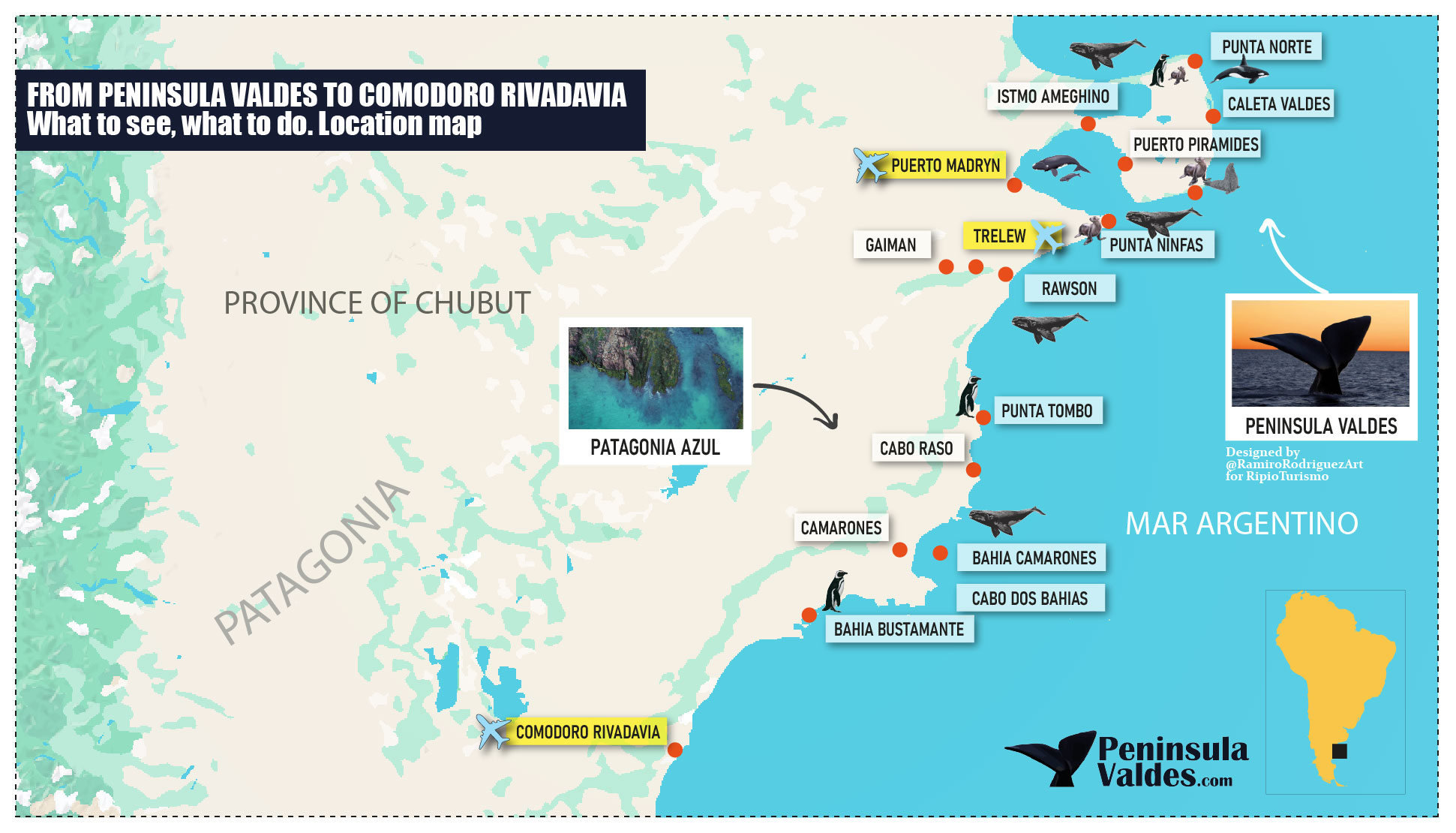General Information of Peninsula Valdes's Region
Find below all the information you want about the important regions close to Peninsula Valdes, Puerto Madryn and Trelew.
Puerto Madryn, Peninsula Valdes, and Patagonia Azul
Exploring the Coastal Wonders of Argentine Patagonia from Puerto Madryn to Comodoro Rivadavia is an awesome experienceThe stretch of Argentine Patagonia that extends from Puerto Madryn and the Península Valdés down to Comodoro Rivadavia offers one of the richest and most diverse coastal landscapes in South America. This region, located along the shores of the Golfo Nuevo and the Atlantic Ocean, is a paradise for wildlife lovers, photographers, and adventurous travelers seeking a unique blend of nature, marine life, geology, and cultural heritage.
PUERTO MADRYN AND PENINSULA VALDES
Puerto Madryn is the main gateway to this fascinating area. Known for its deep-blue waters and Welsh heritage, the town is an excellent base for exploring the surrounding nature reserves. Puerto Madryn offers quiet beaches, vibrant promenade, and cozy cafés make it a pleasant place to stay. Just a short drive away is Península Valdés, a UNESCO World Heritage Site and one of the top destinations for wildlife watching in the world. Depending on the season, visitors can see southern right whales (from June to December), elephant seals, sea lions, penguins, orcas, and a wide variety of seabirds. The peninsula is also home to striking landscapes of salt flats, cliffs, and arid steppe, giving a real sense of Patagonia’s raw beauty.
TRELEW, GAIMAN, WESH COLONIES AND DINOSAURS OF PATAGONIA
Heading south from Puerto Madryn, one can explore the small coastal towns of Trelew and Gaiman, each with its own cultural flair. Trelew is known for the MEF (Museo Egidio Feruglio), one of the most important paleontology museums in South America, housing spectacular dinosaur fossils found in the region. Nearby, Gaiman preserves the legacy of the Welsh settlers, with traditional tea houses and charming stone houses nestled in the valley. Trelew is the main airport of the area, so visiting this place is very usual when you go to Peninsula Valdes.
PUNTA TOMBO AND THE PENGUINS
Continuing down the coast, travelers encounter Punta Tombo, one of the largest Magellanic penguin colonies in the world. From September to April, more than half a million penguins gather here to nest and raise their chicks. Walking among them on marked trails is an unforgettable experience. The area is also rich in guanacos, rheas, foxes, and native flora.


BAHIA CAMARONES AND PATAGONIA AZUL PARK
Further south, the landscape becomes even more rugged and remote. The town of Camarones offers a peaceful stop with historical appeal and access to Cabo Dos Bahías, a protected area with more penguin colonies and pristine coastal views. This is an ideal place for those seeking off-the-beaten-path experiences.
Just outside the town of Camarones lies Bahía Camarones, a quiet and scenic bay surrounded by rugged coastline and crystal-clear waters. It’s part of the broader Patagonia Azul conservation area, officially known as the Parque Interjurisdiccional Marino Costero Patagonia Austral, one of the largest marine protected areas in Argentina. This region is a haven for marine biodiversity, home to a rich variety of seabirds, dolphins, sea lions, and fish species, many of which are endemic or threatened. The area also contains important breeding grounds for species such as the imperial cormorant and the South American fur seal. For travelers, Patagonia Azul offers a chance to experience the wild Atlantic coast in its most pristine form, with opportunities for kayaking, birdwatching, hiking, and connecting with local conservation projects. The landscapes here are remote and untouched, offering a sense of peace and immersion in nature that is rare and deeply rewarding.
COMODORO RIVADAVIA, THE INDUSTRIAL CITY
Finally, the route leads to Comodoro Rivadavia, a key city in southern Chubut with a strong identity rooted in the oil industry. While more industrial in appearance, the city still offers points of interest like the Astra Museum, beautiful cliffside beaches, and nearby nature reserves such as Rada Tilly, a seaside resort known for its wide beaches and opportunities for windsurfing and sandboarding. The nearby Bosque Petrificado Sarmiento (Sarmiento Petrified Forest) is another fascinating stop, showcasing ancient fossilized trees in a surreal desert setting.
This journey can be combined into a comprehensive road trip, best done by car or with guided tours, allowing travelers to appreciate the changing landscapes—from coastal cliffs and marine life to steppe, canyons, and fossils. The region is ideal for eco-tourism, wildlife photography, geological exploration, and learning about the interwoven natural and cultural history of Patagonia.
Whether you’re watching a whale breach off the coast of Puerto Pirámides, walking among penguins at Punta Tombo, sipping tea in a Welsh village, or standing in awe before petrified trees, this stretch of Patagonia is rich in contrast and full of unforgettable moments.

